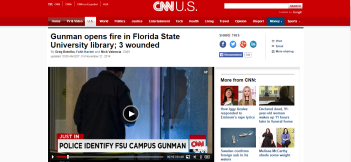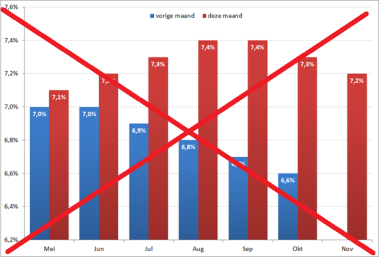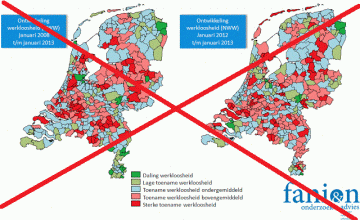See the picture above of the frame? As you are looking it now, you can see the nice golden borders. You are looking at the ‘pretty’ side of the frame. The side that is used the most and that you would find in most households that actually have this frame. You probably put a nice picture in it of your family, friends, a beautiful landscape or whatever you like. But this is not the only way to display the picture. You can also turn it around and have the pretty side face the wall. Now you would see the back of the frame. Maybe to some it would be less attractive, but it is still a possibility. Does this change the picture or the frame? No, it doesn’t. It merely shows another side of it. It changes your perspective on the frame, but it doesn’t change the frame itself. This change of perspective I just described is called framing.
As Robert Entman describes it (on page 52): “Framing essentially involves selection and salience. To frame is to select some aspects of a perceived reality and make them more salient in a communicating text, in such a way as to promote a particular problem definition, causal interpretation, moral evaluation, and/or treatment recommendation for the item described”. When they are ‘creating news’, journalists also make judgments about framing. They decide how they make news events more comprehensible for their audience.
According to James Druckman the public opinion is influenced by the frames elites choose to use. He states that the elite can, for example, influence whether the public sees a certain event as a free speech issue or a public safety issue. It is important to note that the word ‘influence’ is key here. As Craig Watkins said, frames do not determine what people think. According to Entman the effect of framing doesn’t merely stem from what they include, but also what they exclude. Or in other words, it is not just about what you say but also what you do not say. It is, however, the question if it is good or bad that some pieces of information are included and some are excluded.
To show you an example of framing, take a look at these articles. If you just look at the title alone of the article by the Guardian and the article by Cosmopolitan, you can see the way they have framed the news that the chocolate production might come to end. Of course, this example is a little extreme and the Cosmopolitan is not an actual news organization, but it does show you how different writers can portray the same story in different ways. As you can see, the Cosmopolitan (jokingly) describes this news as devastating and recommends everyone to stop eat chocolate now before it is too late. The Guardian takes a more neutral approach and also describes the facts later in the article.
Source
When you look at these articles, do you think framing is good or bad? Does it matter to you that the same situation is portrayed differently in this case?
Now, look at these three examples about the shooting on the university campus in Florida. If you take a closer look at all three articles, you can see more differences. But the following differences are the most noticeable.
If you just look at the titles of the articles, you can already see differences. News organization CNN and the magazine TIME focus on the wounded students, while the non-profit news organization NPR focuses on the gunman who has been shot dead by the police.

Source
Source
Not only differences in the titles are noticeable, but also what they author has focused on. The CNN article, for instance, reports a quote by a student about the shooting: “As Kalich said, “Yes, the students (who) were in the library were affected. But 40,000 students lost their sense of security”.” As you can see by quoting this perspective, the CNN focuses more on the students and not just the students that were at the campus during the shooting.
The article by the Time quoted another student: ““This is always stuff you hear about happening at other schools like there are other crazed gunman at colleges but not at Florida State,” student Blair Stokes, who was in the library during the incident, told CNN. “I think this is another issue about gun control and about how we can be doing more in America”.” Do you see the difference? By reporting this quote the Time has shown that this was not the first shooting in a university in America and has implicated in this way that a stricter gun control is necessary.
Yet another student was quoted by NPR: “Allison Kope, a freshman from Cocoa Beach, Fla., said she was on the library’s first floor when she heard a loud noise. People began screaming about a gunman, she told the AP. “You never think something like this is going to happen to you until you have to react in that situation when someone is screaming there is a gun in the building. I ran for my life,” she told the agency. “I ran right out the back door. My laptop and everything is still in there. It was shock. It was just instinct. You don’t think about anything else, you just go”.” As you can tell by this quote, the NPR focuses more on the shooting itself and what happened during the shooting.
When you look at these articles, has your opinion about framing changed? Do you think framing is good or bad now?
In my opinion whether framing is a positive of negative thing depends on the topic you’re dealing with. In the case of the first examples about the chocolate production coming to end, I don’t think it is necessarily bad or good to frame the story. I think you can portray it anyway you want it. However, when the topic you’re dealing with is more serious, I would strongly recommend you to be more careful about how you portray the event. Matters like the school shooting in Florida, are far more serious and are carefully read. As a journalist, you need to look at it that way as well. Try to be objective and not only show your view on the matter. And yes, it is almost impossible to be complete objective as a journalist. You always put your own vision or perspective on a matter into your story, whether it is intentional or not. So what should you do? How can you still be as objective as you can? First of all, try to get all the facts. Even if you yourself don’t agree with some view, make sure you still get the information. It is your job as a journalist to gather information, so the public can form their own opinion. That also brings me to the second thing; try to show more sides to the story. Look at the event from different perspectives. And lastly, do not assume anything. Be critical and look for the most accurate, trustworthy information.














